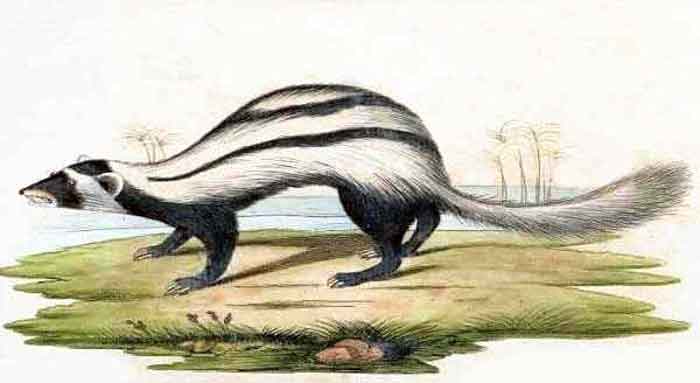
Superregnum: Eukaryota
Cladus: Unikonta
Cladus: Opisthokonta
Cladus: Holozoa
Regnum: Animalia
Subregnum: Eumetazoa
Cladus: Bilateria
Cladus: Nephrozoa
Superphylum: Deuterostomia
Phylum: Chordata
Subphylum: Vertebrata
Infraphylum: Gnathostomata
Megaclassis: Osteichthyes
Cladus: Sarcopterygii
Cladus: Rhipidistia
Cladus: Tetrapodomorpha
Cladus: Eotetrapodiformes
Cladus: Elpistostegalia
Superclassis: Tetrapoda
Cladus: Reptiliomorpha
Cladus: Amniota
Cladus: Synapsida
Cladus: Eupelycosauria
Cladus: Sphenacodontia
Cladus: Sphenacodontoidea
Cladus: Therapsida
Cladus: Theriodontia
Cladus: Cynodontia
Cladus: Eucynodontia
Cladus: Probainognathia
Cladus: Prozostrodontia
Cladus: Mammaliaformes
Classis: Mammalia
Subclassis: Trechnotheria
Infraclassis: Zatheria
Supercohors: Theria
Cohors: Eutheria
Infraclassis: Placentalia
Cladus: Boreoeutheria
Superordo: Laurasiatheria
Cladus: Scrotifera
Cladus: Ferungulata
Cladus: Ferae
Cladus: Pancarnivora
Cladus: Carnivoramorpha
Cladus: Carnivoraformes
Ordo: Carnivora
Subordo: Caniformia
Infraordo: Arctoidea
Superfamilia: Musteloidea
Familia: Mustelidae
Subfamilia: Mustelinae
Genus: Ictonyx
Species: Ictonyx libyca
Subspecies: I. l. libyca – I. l. multivittata – I. l. oralis – I. l. rothschildi
Name
Ictonyx libyca (Hemprich & Ehrenberg, 1833)
Type locality: "Libyae" [Libya].
References
Symb. Phys. Mamm., vol. 1(pt. 2, sig. K): verso.
Ictonyx libyca in Mammal Species of the World.
Wilson, Don E. & Reeder, DeeAnn M. (Editors) 2005. Mammal Species of the World – A Taxonomic and Geographic Reference. Third edition. ISBN 0-8018-8221-4.
IUCN: Ictonyx libyca (Hemprich & Ehrenberg, 1833) (Least Concern)
Ictonyx libycus (Hemprich & Ehrenberg, 1833) – Taxon details on Integrated Taxonomic Information System (ITIS).
Vernacular names
Deutsch: Streifenwiesel
English: Saharan Striped Polecat
español: Zorrilla líbica o norteafricana
polski: Zorilla libijska
The Saharan striped polecat (Ictonyx libycus), also known as Saharan striped weasel and Libyan striped weasel, is a species of mammal in the family Mustelidae.[1]
Characteristics
The Saharan striped polecat is white with dark random stripes. It has black feet, legs, ears and undersides. Often, a white ring goes around the face and above a black snout. They are sometimes confused with the striped polecat, though are generally smaller and have distinct facial markings. It is about 55–70 cm (22–28 in) in length, including tail and generally weighs between 0.5 and 0.75 kg (1.1 and 1.7 lb).[2]
Distribution and habitat
The Saharan striped polecat is distributed around the northern and southern edges of the Sahara in Mauritania, Western Sahara and Morocco in the west along the Mediterranean littoral of North Africa to the Nile Valley in Egypt, while in the south its range is the Sahel east to Sudan and Djibouti.[1] The Saharan striped polecat prefers steppe-like habitat and lives on the margins of deserts, especially in mountains, in arid, stony terrain and sandy semi-deserts, but rarely in woodlands.[3]
Behaviour and ecology
Saharan striped polecat
The Saharan striped polecat is nocturnal and solitary. It hides during the day in other animals' burrows or digs its own. It generally gives birth to one to three young in spring.[2] It moves about at night in the open in a quite deliberate way, with its tail held vertically.[3] It is known to spray a foul, skunk-like anal emission when threatened.[4] Before releasing the anal emission, it raises its fur in an attempt to warn the potential attacker.[5]
Diet
It eats primarily eggs, small birds, small mammals, and lizards.[5] Much of its prey is tracked down by scent and dug out of burrows, and although it is normally a slow, deliberate mover, it can move quite rapidly and pounce quickly when pursuing prey.[3]
Reproduction
It generally gives birth to one to three young in spring.[2]
Threats
In Tunisia, Saharan striped polecats are often caught and exploited because of the tribal belief that they may increase male fertility.[1]
Taxonomy
The Saharan striped polecat is sometimes characterized as being a part of the genus Poecilictis.[6][1]
The following subspecies have been proposed for the Saharan striped polecat:[citation needed]
I. l. libycus
I. l. multivittatus
I. l. oralis
I. l. rothschildi
References
Ahmim, M.; Do Linh San, E. (2015). "Ictonyx libycus". IUCN Red List of Threatened Species. 2015: e.T41645A45212347. doi:10.2305/IUCN.UK.2015-4.RLTS.T41645A45212347.en. Retrieved 15 November 2021.
Hoath, R. (2009). A Field Guide to the Mammals of Egypt. Egypt: The American University in Cairo Press. pp. 82–84. ISBN 9789774162541.
Kingdon, J. (1997). The Kingdon Field Guide to African Mammals. Academic Press. p. 229. ISBN 978-0-12-408355-4.
Newman, C.; Buesching, C.D. & Wolff, J.O. (2005). "The function of facial masks in midguild carnivores" (PDF). Oikos. 108 (3): 623–633. doi:10.1111/j.0030-1299.2005.13399.x. JSTOR 3548808.
Hoath, R. (2009). A Field Guide to the Mammals of Egypt. Egypt: The American University in Cairo Press. p. 83. ISBN 9789774162541.
Ball, M. (1978). "Reproduction in captive-born zorillas". International Zoo Yearbook. 18 (1): 140–143. doi:10.1111/j.1748-1090.1978.tb00245.x.
Retrieved from "http://en.wikipedia.org/"
All text is available under the terms of the GNU Free Documentation License

